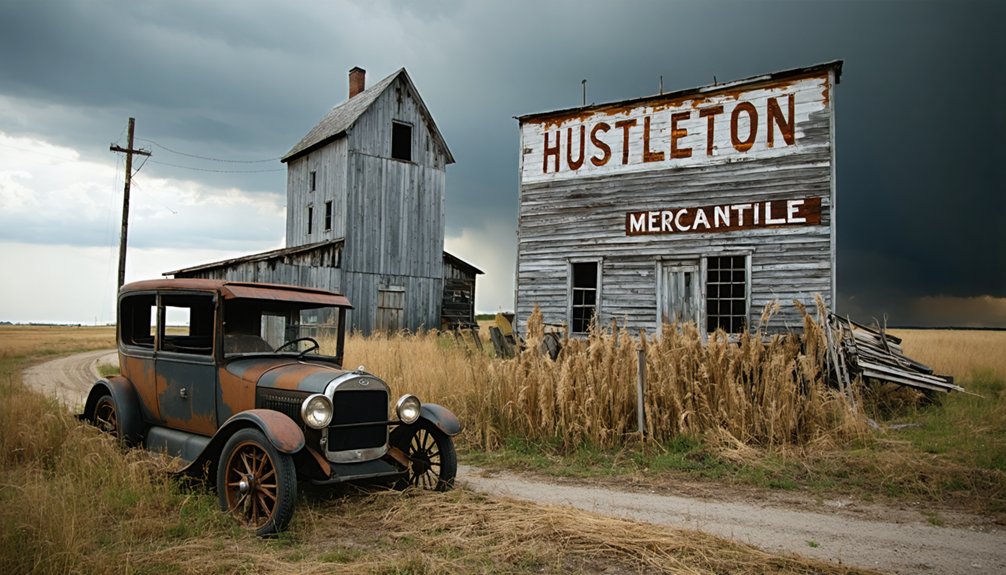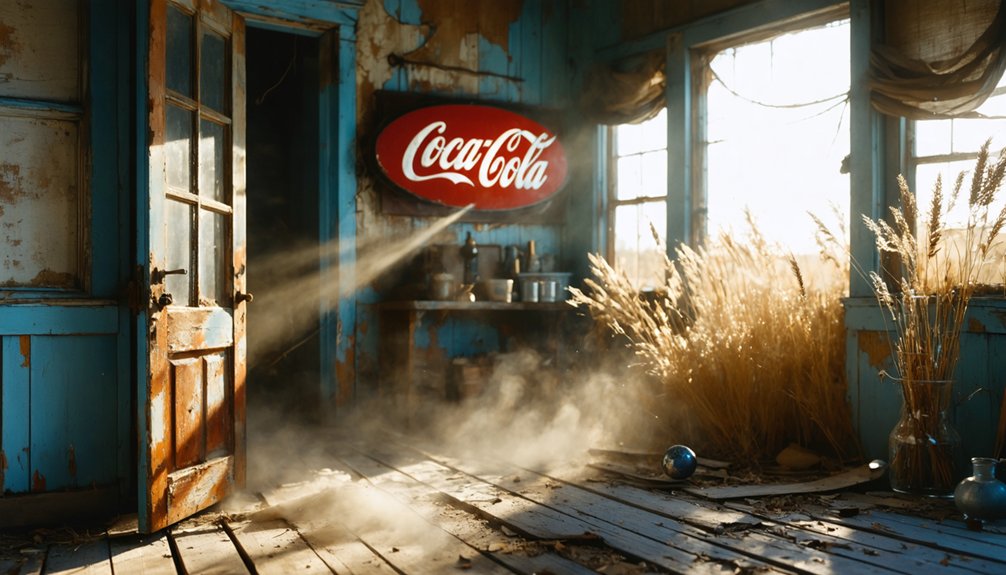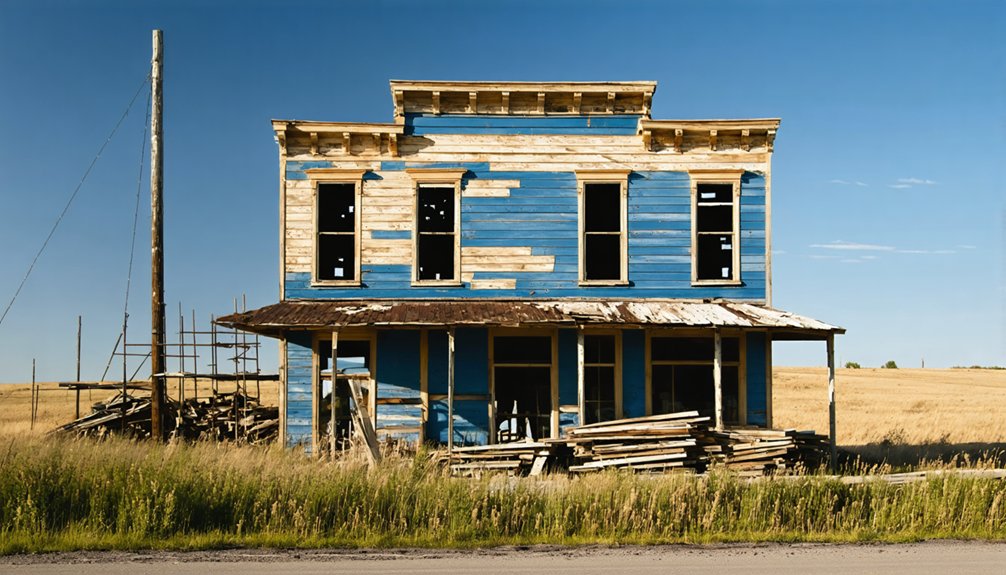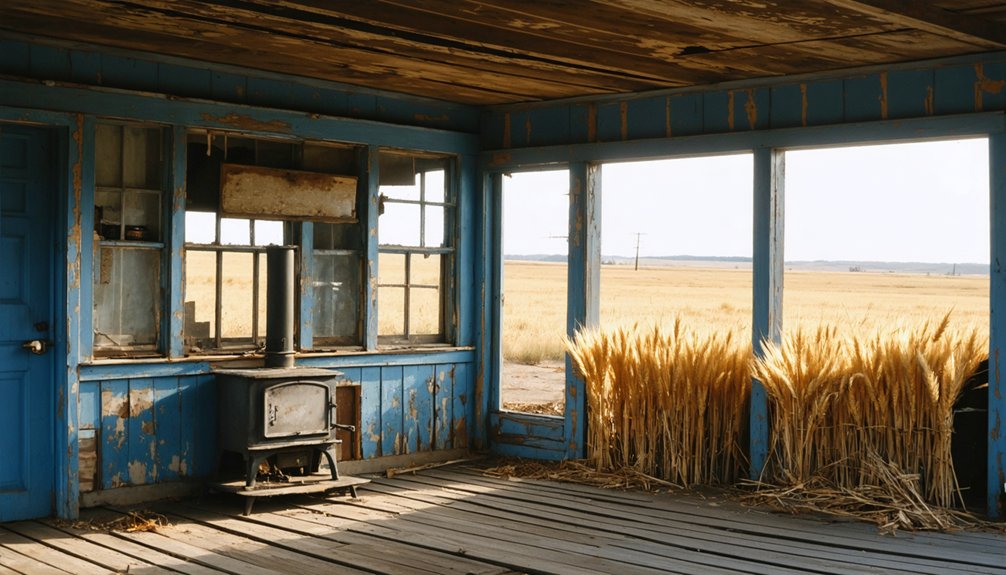You’ll find Hustleton nestled in South Dakota’s Black Hills, where gold fever sparked a mining rush in 1875. Hundreds of prospectors staked claims along Castle Creek, transforming the area into a bustling frontier town with saloons and general stores. Though mining operations thrived initially, the town later shifted to agriculture when gold became scarce. Today, weathered ruins and grain elevators tell the story of this once-vibrant community, where pioneer tales and architectural remnants await your discovery.
Key Takeaways
- Hustleton began as a gold mining settlement in 1875 along Castle Creek, attracting numerous placer miners during the Black Hills rush.
- The town evolved from mining to agriculture in the late 1800s, with railroad connections to Chicago and Sioux City facilitating trade.
- Pioneer life included harsh winters and primitive living conditions, with miners working dawn shifts and gathering at local establishments.
- Economic decline struck in early 1900s when mining became unprofitable, leading to population exodus and closure of businesses.
- Historical structures remain, including grain elevators and mining ruins, now protected by South Dakota State Historical Society despite preservation challenges.
The Birth of a Mining Town
As gold fever swept through the Black Hills in 1875, waves of placer miners descended on what would become Hustleton, drawn by promising rumors of rich deposits along Castle Creek.
You’d have found these early prospectors establishing their claims along the creek, setting up flumes and sluices to wash gold from the gravels in typical placer mining techniques.
Like many Black Hills settlements of the era, Hustleton grew haphazardly as miners rushed to stake their claims. The town took shape quickly, with community events centered around the daily rhythm of mining life. They followed the pattern seen across the region, where over six hundred towns would eventually become abandoned settlements. The area’s history paralleled that of Garden City, which would later be renamed to Maitland in 1902.
However, the miners soon discovered that Castle Creek’s gold deposits lay frustratingly deep beneath layers of slate, making traditional placer methods impractical. Many claims were abandoned as prospectors moved on to more promising locations, setting the stage for Hustleton’s eventual decline.
Gold Rush Dreams and Early Settlement
When you’d stake a mining claim in Hustleton during the 1876 Black Hills rush, you’d join hundreds of prospectors working the placer deposits along nearby creeks and gulches.
You’d face the harsh realities of frontier life, from bitter Dakota winters to the constant threat of claim jumpers and disputes with other miners. By this time, free milling techniques were commonly used to extract gold from the ore.
Living in rough-hewn cabins or canvas tents, you’d have spent long days panning and sluicing while dreaming of striking the next Homestake-sized deposit. The discovery of gold by Custer’s expedition team in 1874 had sparked this fevered migration of fortune seekers to the region.
Mining Claims and Prospects
The discovery of gold in the Black Hills during 1874 ignited a stampede of fortune-seekers, with the region’s most significant claim established on April 9, 1876, when Fred and Moses Manuel, Hank Harney, and Alex Engh located the Homestake lode near present-day Lead.
The Homestake Mine produced an astounding 10% of world gold throughout its 125-year history.
By 1875, illegal prospectors numbering around 4,000 had entered the region despite treaty restrictions.
You’ll find mining techniques varied based on ore types and location:
- Placer mining dominated early efforts, extracting loose gold from streambeds.
- Free-milling methods crushed quartz rock and used mercury amalgamation.
- Refractory ore required advanced chlorization and smelting processes.
- Stamp mills processed harder rock as surface gold depleted.
Pioneer Life and Hardships
Mining success in the Black Hills brought more than technical challenges – it tested the human spirit in profound ways.
You’d have faced brutal pioneer struggles: primitive housing, scarce supplies, and the psychological weight of isolation. Living in hastily built camps like Deadwood, you’d battle harsh winters and rugged terrain while competing with thousands of other unauthorized settlers on Sioux land.
Settlement resilience meant adapting to a world where clean water and food weren’t guaranteed. You’d risk your life daily, whether panning for gold in icy streams or traversing dangerous underground passages filled with toxic mercury fumes. The introduction of chlorination and smelting by 1890 finally made processing difficult gold ores possible. Initial prospectors at French Creek could earn fifty to seventy-five dollars per day with dedicated work.
While some struck it rich, most miners remained poor, their dreams of wealth crushed by the realities of free-milling gold’s scarcity and the physical demands of placer mining.
Life in Bustling Hustleton
You’d have found daily mining operations at Hustleton starting at dawn, with miners working long, exhausting shifts underground while their families supported the community above.
The town’s spirit came alive each evening as workers gathered at the general store and local saloon to share stories of their day’s fortunes and challenges. Much like the town of Awanka, the community once boasted two thriving hotels where travelers and workers found rest.
While specific details of Hustleton’s peak period remain uncertain, historical patterns of similar Black Hills mining communities suggest a close-knit population where neighbors helped neighbors through the demanding work of frontier life. Like many towns that relied on mineral extraction, the community eventually faced decline when the mine lost profitability.
Daily Mining Operations
During Hustleton’s peak years, daily mining operations followed a predictable yet demanding rhythm that shaped life in this bustling South Dakota town. You’d find miners employing both placer and hardrock mining techniques, adapting their methods as surface gold deposits grew scarce.
The ore processing operations ran almost continuously, with stamp mills crushing rock day and night.
Your typical day in Hustleton’s mines would include:
- Operating steam-powered equipment to extract ore from increasingly complex geological formations
- Maintaining critical railroad connections for transporting ore and essential supplies
- Processing low-grade ore through advanced milling technology
- Managing constant equipment repairs while dealing with challenging safety conditions
The demanding nature of mining created a tough but resilient community, where your success depended on adapting to both economic pressures and technological advancements.
Small-Town Community Spirit
Community spirit flourished in bustling Hustleton, where the rhythms of daily life extended far beyond the mines. You’d find yourself drawn into regular community gatherings at the local church, where neighbors shared stories and strengthened bonds that held the town together.
Local traditions, from seasonal festivals to community picnics, marked the passing of time and celebrated the town’s shared identity.
Like many small South Dakota towns, Hustleton’s social fabric was tightly woven through agricultural ties and mutual support.
The community center served as a vibrant hub where you could join in social activities, from holiday celebrations to town meetings.
These gatherings weren’t just social events – they were the heartbeat of the community, fostering the resilient spirit that defined small-town life in South Dakota.
Transportation and Economic Growth
Transportation networks transformed Hustleton from an isolated prairie settlement into a thriving agricultural hub in the late 1800s.
Railroad expansion brought unprecedented opportunities, connecting you directly to major markets like Chicago and Sioux City. You’d find the railroad depot serving as your community’s lifeline, where you could ship your grain, receive mail, and catch up on news.
- If you were a farmer, you’d ride the freight cars for free while shipping your livestock.
- You’d store your grain in elevators built strategically along rail sidings.
- Your land values would rise considerably due to rail proximity.
- You’d benefit from reliable year-round shipping, unlike the seasonal ox-drawn freight.
The railroad’s impact reached beyond transportation, creating jobs and establishing Hustleton as a crucial agricultural shipping point in South Dakota’s growing economy.
The Decline Years

Once the mining industry began to falter in the early 1900s, Hustleton’s fate quickly unraveled.
You’d have witnessed mass population migration as miners and their families left for nearby Deadwood and Lead, seeking new opportunities. The economic collapse hit hard – stores closed, hotels shuttered, and the town’s tax base crumbled.
Social fragmentation tore through the community as schools and churches closed their doors.
You couldn’t maintain a community identity when your neighbors were leaving one by one.
Environmental degradation from years of mining and logging left the land barren, while harsh Dakota winters made life increasingly difficult for those who stayed.
Architectural Legacy and Remnants
While many Black Hills ghost towns have vanished entirely, Hustleton’s architectural remnants tell a compelling story of frontier life.
You’ll find practical architectural styles that relied on locally-sourced construction materials, particularly timber from nearby sawmills and sandstone from regional quarries. The surviving structures reflect the town’s working-class roots and rapid development needs.
Hustleton’s builders crafted no-nonsense structures from local timber and sandstone, mirroring the practical spirit of frontier development.
- Weathered grain elevators and barns stand as evidence of Hustleton’s agricultural heritage.
- Brick and stone ruins preserve fragments of commercial buildings that once served miners and railroad workers.
- Warped wooden church remnants showcase some of the most enduring pioneer architecture.
- Foundation outlines and scattered stonework reveal where homes and businesses once thrived.
These architectural vestiges, though deteriorating, continue to narrate Hustleton’s boom-and-bust saga in the Black Hills region.
Tales From Former Residents

You’ll find the stories of Hustleton’s mining families reveal grueling 12-hour shifts spent in dark, damp tunnels where fathers and sons worked side-by-side extracting precious ore.
After most residents departed in the early 1900s, the Johnsons remained as the last family in town for nearly a decade, operating their general store despite dwindling customers and harsh Dakota winters.
Through oral histories gathered from the Johnson children, you can piece together how they maintained hope even as neighboring buildings deteriorated and longtime friends moved away to larger settlements.
Daily Life Underground
Through the accounts of former Hustleton residents, a rich tapestry of underground life emerges from this South Dakota ghost town’s past.
You’ll find the mining community’s cultural identity deeply rooted in these subterranean spaces, where psychological resilience shaped their daily existence. Adapting to local challenges, they transformed underground storage areas into vibrant hubs of activity.
- Root cellars served as communal gathering spots during harsh weather, fostering storytelling and strengthening bonds.
- Craftsmen worked on leather goods and tool repairs in these spaces, sheltered from extreme surface conditions.
- Ventilation challenges were overcome through carefully constructed shafts and chimneys.
- Connected passageways allowed residents to move between buildings while avoiding brutal winter weather.
These historical adaptations and local narratives reveal a community that turned underground survival into an art form.
Last Family Standing
As underground life shaped Hustleton’s community spirit, it was the last remaining family that witnessed its final heartbeat.
You’ll find their story marked by resilience and adaptation, as they maintained a small general store serving occasional travelers while preserving the ghost town’s fading heritage.
Through brutal winters and crumbling infrastructure, this final family held on until the 1970s, running one of the last operational businesses in the area.
They’d share tales of the town’s mining glory days with passing tourists, sometimes offering guided tours of abandoned structures.
Despite their efforts to keep Hustleton’s pulse alive through small tourism ventures, the isolation and lack of basic services eventually proved too challenging.
When they finally departed, their exodus marked Hustleton’s complete transformation from struggling community to true ghost town.
Exploring the Ghost Town Today
Today’s visitors to Hustleton will find a silent tribute to South Dakota’s mining era nestled within the Black Hills region.
As you venture into this ghost town exploration site, you’ll discover weathered remnants of a once-thriving community, now reclaimed by nature. The historical significance of Hustleton emerges through its surviving structures and foundations.
When visiting this remote location, you’ll want to:
- Navigate using GPS or detailed maps, as signage is limited
- Stick to marked paths and respect private property boundaries
- Bring a camera to capture the atmospheric ruins and foundations
- Combine your visit with other nearby ghost towns for a fuller Black Hills experience
Remember to tread carefully around deteriorating structures and avoid disturbing any artifacts you might encounter during your exploration.
Preservation Efforts and Challenges

While preserving Hustleton’s historical legacy remains a priority for the South Dakota State Historical Society, the ghost town faces numerous preservation challenges that threaten its surviving structures.
You’ll find environmental threats like harsh weather and ground shifting continuously degrading the site’s fragile buildings and foundations. Limited access to the remote location complicates regular maintenance practices, while vandalism issues and artifact theft pose ongoing risks to the town’s historical significance.
Community involvement through volunteer initiatives helps support basic restoration efforts, but funding strategies remain limited.
Tourism impact presents a double-edged sword – while it can generate preservation resources, excessive foot traffic accelerates deterioration. The Historical Society balances these concerns through controlled access measures, educational signage, and strategic maintenance to protect what remains of this piece of South Dakota history.
Photography and Tourism Guide
Looking to capture the haunting beauty of Hustleton? You’ll find this Black Hills ghost town offers incredible photographic techniques for capturing its historical context, from weathered mining remnants to mysterious cemeteries.
Access requires traversing unpaved roads, so bring a high-clearance vehicle and GPS coordinates.
Prepare for rugged travel to reach this hidden gem – a high-clearance vehicle and reliable GPS are essential companions.
For the best shots, consider:
- Long exposure night photography to capture star-filled skies with minimal light pollution
- Seasonal variations like autumn colors or winter snow for enhanced contrast
- Early morning or late afternoon light for dramatic shadows on decaying structures
- Strategic compositions incorporating mill foundations and rustic cabin ruins
Pack plenty of water, emergency supplies, and sturdy hiking boots.
While exploring, remember to respect preservation guidelines and watch for unstable structures.
You’ll want to combine your visit with nearby Custer State Park’s attractions for a full Black Hills adventure.
Frequently Asked Questions
Are There Any Documented Paranormal Activities or Ghost Sightings in Hustleton?
You won’t find any documented ghostly encounters or spectral sightings in Hustleton. While surrounding Black Hills ghost towns have paranormal legends, there’s no official record of supernatural activity in this location.
What Happened to the Cemetery and Burial Grounds of Original Settlers?
You’ll find most original burial markers deteriorated beyond recognition. While cemetery restoration efforts exist in South Dakota ghost towns, specific records of Hustleton’s burial ground preservation haven’t been well documented.
Did Any Famous Outlaws or Historical Figures Ever Visit Hustleton?
You won’t find verified records of outlaw legends or historical visits to Hustleton. While the Black Hills region attracted famous figures, there’s no concrete evidence they specifically stopped in this lesser-known settlement.
Were There Any Native American Settlements Before Hustleton Was Established?
Like countless stars in the night sky, Native tribes inhabited this land for millennia. You’ll find Sioux, particularly Dakota and Lakota bands, established seasonal settlements throughout the region before Hustleton’s founding.
Did Hustleton Experience Any Major Crimes or Notable Lawlessness During Operations?
You won’t find major crime statistics or significant law enforcement records from Hustleton’s operational period. Available historical documents show no documented violent incidents, robberies, or widespread lawlessness in the mining town.
References
- https://www.powderhouselodge.com/black-hills-attractions/fun-attractions/ghost-towns-of-western-south-dakota/
- https://www.sdhspress.com/journal/south-dakota-history-2-2/some-black-hills-ghost-towns-and-their-origins/vol-02-no-2-some-black-hills-ghost-towns-and-their-origins.pdf
- https://www.sdpb.org/rural-life-and-history/2023-08-21/some-black-hills-ghost-towns-and-their-origins
- https://www.youtube.com/watch?v=Glucs_Rq8Xs
- https://www.youtube.com/watch?v=_0WNYsFLSLA
- https://www.blackhillsbadlands.com/blog/post/old-west-legends-mines-ghost-towns-route-reimagined/
- https://en.wikipedia.org/wiki/List_of_ghost_towns_in_South_Dakota
- https://icatchshadows.com/okaton-and-cottonwood-a-photographic-visit-to-two-south-dakota-ghost-towns/
- https://www.onlyinyourstate.com/experiences/south-dakota/capa-ghost-town-sd
- https://blackhillsvisitor.com/learn/maitland/



